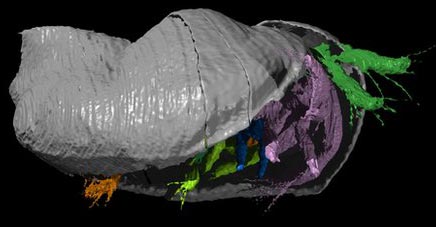Ancient Ostracod from Herefordshire – Reconstructing the Silurian
Pauline avibella – A new Species of Silurian Ostracod named after Professor’s Wife
It may be difficult to believe, especially after the sub-zero temperatures endured by many people in the United Kingdom over recent days, but once the landmass that was to form England sat much closer to the equator than it does today. Back in the Silurian, much of the land that we now know as the UK was underwater, part of an extensive, shallow sub-tropical sea that marked the boundary between two landmasses, Laurentia in the west and Baltica in the north. Scientists from the University of Leicester (East Midlands), have identified a new species of crustacean, an animal that lived in this warm, shallow sea something like 425 million years ago.
Silurian Ostracod
The one centimetre long shelled creature had been found in rocks in Herefordshire, from a site that University of Leicester researchers describe as a “treasure trove” of fossil material. It seems that part of the sea bed had been covered by a fine layer of volcanic ash as a volcano to the west erupted. This ash layer buried much of the lifeforms that existed in the area at the time, preserving their bodies and hard shells in exquisite detail. The fossils have soft tissue and even components such as eyes and mouth parts have been preserved.
Pauline avibella
Professor David Siveter, who led the research, has named the new species Pauline avilbella in honour of his late wife who supported him throughout his career. Ostracods are relatively abundant in the fossil record. These primitive shelled arthropods of the Order Crustacea are related to crabs, lobsters, barnacles and shrimps. The fossils of these tiny creatures first appear in Cambrian rocks and although these creatures first evolved in a marine environment, many modern species can be found in freshwater. Like all Arthropoda, these animals have bilateral symmetry and their paired body parts are usually enclosed in a hinged, bivalve-like shell made of magnesium calcite. One piece of the shell structure is normally bigger than the second part of the shell and these shells are commonly preserved in the fossil record, however, being able to identify soft tissue parts in Silurian aged fossils is extremely rare.
A Computer Generated Image of the New Ostracod Species
Picture credit: Press Association/University of Leicester
An Important Discovery
Commenting on the new species, Professor Siveter, the lead author of the scientific paper, stated that this was a very important discovery as it represented one of only a handful of fossil Ostracods with the soft-tissues preserved. The species name “avibella” was chosen as the two piece shell resembles the shape of a bird’s wing. Most Ostracod shells are kidney or bean shaped, but this particular shallow water species had a shell that was swept back, similar to the shape of the wing of a bird. The name “avibella” means “beautiful bird”.
The process of extracting the tiny microfossils from the surrounding limestone matrix involves slowly grinding the specimen down, micron by micron with scanning photographs taken at each stage. When the mechanical process is completed the data is fed into a powerful computer which can produce a detailed three-dimensional image of the organism, including its delicate soft body parts. With each specimen more than five hundred images were produced, resulting in an extremely detailed picture of the organism – a sort of “virtual fossil”.
Diversity of Marine Fauna During the Silurian
The work of the Leicester University based team is helping scientists to understand the diversity of benthic (animals and plants that live on the sea floor), marine fauna during the Silurian period, an important period in the evolution and diversity of marine organisms as rising sea levels created a number of warm, shallow sea environments and fauna was almost entirely restricted to marine habitats.
For figures and replicas of iconic animals from the fossil record such as famous invertebrates like ammonites and trilobites: Ammonites, Belemnites, Trilobites and Other Prehistoric Animal Models (CollectA).


